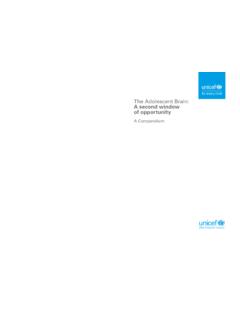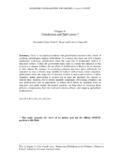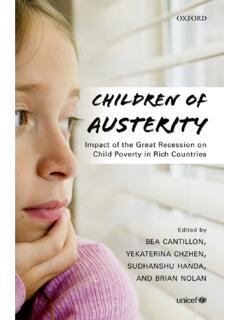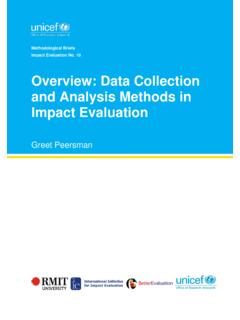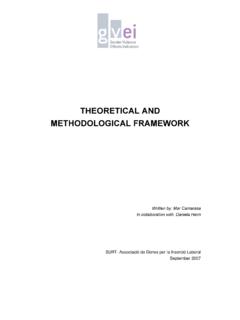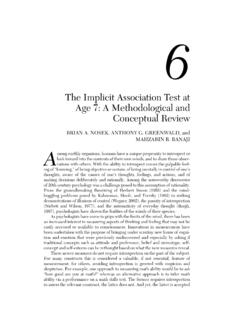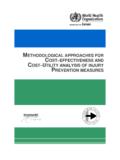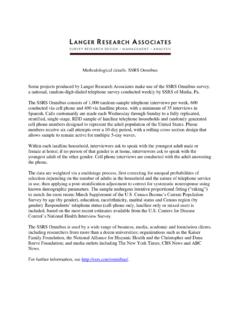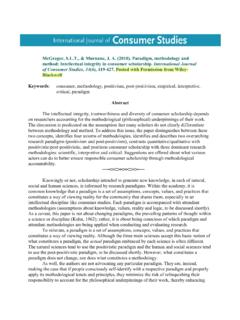Transcription of Methodological Briefs Impact Evaluation No. 9 - UNICEF-IRC
1 Methodological Briefs Impact Evaluation No. 9 Comparative Case Studies Delwyn Goodrick UNICEF OFFICE OF RESEARCH The Office of Research is UNICEF s dedicated research arm. Its prime objectives are to improve international understanding of issues relating to children s rights and to help facilitate full implementation of the Convention on the Rights of the Child across the world. The Office of Research aims to set out a comprehensive framework for research and knowledge within the organization, in support of UNICEF s global programmes and policies, and works with partners to make policies for children evidence-based. Publications produced by the Office are contributions to a global debate on children and child rights issues and include a wide range of opinions. The views expressed are those of the authors and/or editors and are published in order to stimulate further dialogue on Impact Evaluation methods.
2 They do not necessarily reflect the policies or views of UNICEF. OFFICE OF RESEARCH Methodological Briefs UNICEF Office of Research Methodological Briefs are intended to share contemporary research practice, methods, designs, and recommendations from renowned researchers and evaluators. The primary audience is UNICEF staff who conduct, commission or interpret research and Evaluation findings to make decisions about programming, policy and advocacy. This brief has undergone an internal peer review. The text has not been edited to official publication standards and UNICEF accepts no responsibility for errors. Extracts from this publication may be freely reproduced with due acknowledgement. Requests to utilize larger portions or the full publication should be addressed to the Communication Unit at To consult and download the Methodological Briefs , please visit For readers wishing to cite this document we suggest the following form: Goodrick, D.
3 (2014). Comparative Case Studies, Methodological Briefs : Impact Evaluation 9, UNICEF Office of Research, Florence. Acknowledgements: This brief benefited from the guidance of many individuals. The author and the Office of Research wish to thank everyone who contributed and in particular the following: Contributors: Patricia Rogers Reviewers: Nikola Balvin, Roberto Benes, Joaquin Gonzales, Fiachra McAsey 2014 United Nations Children s Fund (UNICEF) September 2014 UNICEF Office of Research - Innocenti Piazza SS. Annunziata, 12 50122 Florence, Italy Tel: (+39) 055 20 330 Fax: (+39) 055 2033 220 Methodological brief : Comparative Case Studies Page 1 1. COMPARATIVE CASE STUDIES: A brief DESCRIPTION A case study is an in-depth examination, often undertaken over time, of a single case such as a policy, programme, intervention site, implementation process or participant. Comparative case studies cover two or more cases in a way that produces more generalizable knowledge about causal questions how and why particular programmes or policies work or fail to work.
4 Comparative case studies are undertaken over time and emphasize comparison within and across contexts. Comparative case studies may be selected when it is not feasible to undertake an experimental design and/or when there is a need to understand and explain how features within the context influence the success of programme or policy initiatives. This information is valuable in tailoring interventions to support the achievement of intended outcomes. Comparative case studies involve the analysis and synthesis of the similarities, differences and patterns across two or more cases that share a common focus or goal. To be able to do this well, the specific features of each case should be described in depth at the beginning of the study. The rationale for selecting the specific cases is directly linked to the key Evaluation questions (KEQs) and, thus, to what needs to be investigated. An understanding of each case is important in establishing the foundation for the analytic framework that will be used in the cross-case comparison.
5 Comparative case studies often incorporate both qualitative and quantitative data. Given the focus on generating a good understanding of the cases and case context, methods such as fieldwork visits, observation, interviews and document analysis often dominate among the various data collection methods employed. While the strategies used in data collection for single and comparative case studies are similar, comparative case studies require more extensive conceptual, analytic and synthesizing work. The synthesis across cases extends beyond the comparison of similarities and differences to using these similarities and differences to support or refute propositions as to why an intervention succeeds or fails. While some degree of comparison is at the heart of any design in which multiple cases are used, the distinguishing feature of comparative case studies is the emphasis on examining causality ( , the extent to which the intervention caused the results, particularly outcomes and impacts).
6 As is the case for experimental and quasi-experimental designs (see brief No. 7, Randomized Controlled Trials and brief , Quasi-experimental Design and Methods), comparative case studies are time and resource-intensive. This is mostly due to the inclusion of iterations between propositions, evidence collection and synthesis. Main points Comparative case studies can be used to answer questions about causal attribution and contribution when it is not feasible or desirable to create a comparison group or control group. Comparative case studies usually utilize both qualitative and quantitative methods. Comparative case studies are particularly useful for understanding and explaining how context influences the success of an intervention and how better to tailor the intervention to the specific context to achieve intended outcomes. Methodological brief : Comparative Case Studies Page 2 2. WHEN IS IT APPROPRIATE TO USE THIS METHOD?
7 As a design option, comparative case studies are suitable in the following circumstances: When how and why questions are being posed about the processes or outcomes of an intervention. When one or more interventions are being implemented across multiple contexts, and there is little or no opportunity to manipulate or control the way in which the interventions are being implemented. When there is an opportunity for iterative data collection and analysis over the time frame of the intervention. When an understanding of the context is seen as being important in understanding the success or failure of the intervention. When experimental and/or quasi-experimental designs are unfeasible for practical or ethical reasons, or to supplement evidence from such Evaluation designs. As with other Evaluation designs and methods, it is essential that the Evaluation team undertaking comparative case studies has the necessary knowledge and skills to implement a comparative approach.
8 Skills are required in qualitative and quantitative methods, concept development and theory testing, and synthesis, and in particular the team must be able to systematically investigate causal questions using techniques such as qualitative comparative analysis and process tracing. 3. HOW TO CONDUCT COMPARATIVE CASE STUDIES Comparative case studies essentially involve six steps, which should ideally be undertaken in the order shown below (see also figure 1). The programme s theory of change (see brief No. 2, Theory of Change) and the KEQs guide the focus and selection of the cases and the dimensions that will be studied. Steps 4, 5 and 6 are likely to involve several iterations and further data retrieval or analysis. 1. Clarify the KEQs and purpose of the Evaluation to determine whether the use of comparative case studies is an appropriate design. 2. Identify initial propositions or theories (see below) to focus the comparative case studies, drawing on the programme s theory of change.
9 3. Define the type of cases that will be included and how the case study process will be conducted. 4. Identify how evidence will be collected, analysed and synthesized within and across cases, and implement the study. 5. Consider and test alternative explanations for the outcomes. 6. Report findings. The sequence of these steps allows for explanatory evidence to be collected and tested iteratively (a major difference that sets comparative case studies apart from experimental and quasi-experimental designs for understanding causality). The cases included in the study can be conducted concurrently or sequentially, depending on the how the programme is being implemented ( , linking the cases to staggered programme implementation) and the Evaluation time frame and budget. Methodological brief : Comparative Case Studies Page 3 Figure 1. The logic of comparative case studies Source: Diagram based on the discussion of case study designs in Yin, Robert K.
10 , Case study research: Design and methods, fifth edition, Sage, Los Angeles, 2014 1. Clarify the KEQs and purpose of the study to determine whether a comparative case studies design is appropriate KEQs will guide decisions about whether or not a comparative case studies design is an appropriate Evaluation design (see also brief No. 2, Theory of Change and brief No. 3, Evaluative Criteria). It is important that Evaluation managers are clear about the purpose of using comparative case studies and define whether they are primarily interested in: a description of the similarities and differences found between cases to generate a holistic view of how the programme worked an interpretation of the implications of those similarities and differences across sites or programmes to guide further implementation, and/or 1. Clarify the key Evaluation questions and the purpose of the evaluation2. Identify initial propositions or theories, drawing on the theory of change3.

